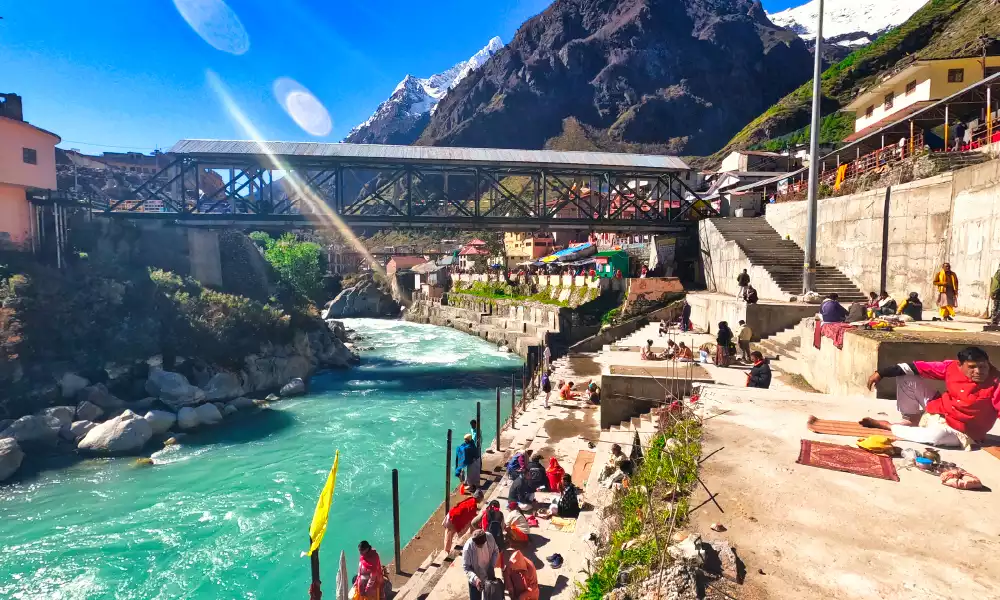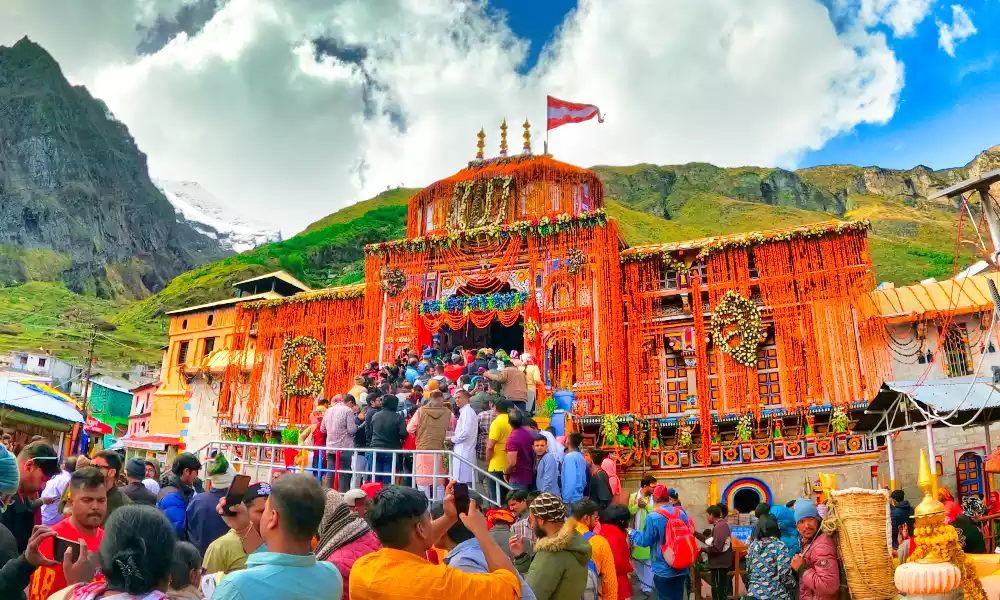Shri Badrinath Temple
The Badrinath Temple is a well-known Hindu temple in the Chamoli area of Uttarakhand, India. It is dedicated to Lord Vishnu. It is one of the four holy sites on the Char Dham Yatra, and Hindus think of it as a very important place to visit. The temple is on the banks of the Alaknanda River, which is 3,133 metres above sea level.

It is surrounded by the tall, snow-capped Himalayan Mountains, which add to its natural beauty and peace. The design of the Badrinath Temple is unique, and it was made in the style of North India. The building is made of stone and has a tall top with a golden spire that looks like a cone. The main entry to the temple is a tall, artistically carved doorway that leads to the inner sanctum, where the main god, Lord Vishnu, is kept.

The black stone statue of Lord Vishnu in the Badrinath Temple is in a meditative pose. Lord Shiva, Goddess Parvati, and Nar-Narayan are among the other idols and gods that live in the temple. Every year, the temple opens in May and stays open until the end of November. During this time, a lot of people from all over the world come to the temple to ask for blessings and say prayers. The Badrinath Temple is important for Sanatan, but it is also very important for history and culture. Several old Hindu texts talk about the temple, and it is thought that the famous Hindu philosopher and saint Adi Shankaracharya built it.
In conclusion, the Badrinath Temple is a Hindu worship site that is known for its unique design, beautiful settings, and religious importance. It is a must-visit place for anyone who wants to grow spiritually and learn about other cultures.
Brahmakapal Ghat

Brahma Kapal ghat is on the banks of the holy river Alakananda, about 250-310 meters north of the Badrinath temple, on the left side of Lord Badrinath. This place is just a walk away and is marked by large black rounded stones which represent the head of Brahma ji. It is struck by the cool waters of the Alakananda river over and over again. Pilgrims visit here to do the Shraddha ritual for their deceased ancestors.
What is Pind daan?

Pind Daan is a Hindu ceremony meant to honour one’s ancestors and give respect to their memory. It is widely held that when a person dies, their spirit travels on to the afterlife, and if their funeral and other ceremonies are not carried out correctly, their soul will not find peace. When doing Pind Daan, it is customary to present the departed soul with some food, water, and other holy articles. It is thought that by conducting this ceremony, not only will the soul find rest, but the individual who does it will also get the blessings of the ancestors. Typically, the ceremony takes place in holy cities like Varanasi, Gaya, & Haridwar.
During the ceremony, the priest chants mantras while presenting pindas and other gifts to the departed soul. The ritualist also purifies themselves by bathing in the sacred river. According to Hindu belief, the Pind Daan ritual might bring its practitioner tranquilly and freedom from the cycle of life and death.
Last Pind Daan at Badrinath Brahma Kapal

The Skanda Purana says that doing a Shradha ceremony in Badrinath kshetra is 8 times better than doing a Shradha ceremony in Gaya kshetra. This is the reason, pilgrims perform Pind daan at Brahma Kapal. It is also said ancestors who did not find salvation in Gaya or in any other location may find it here by completing a shradha ritual. This is the only way for them to be saved. Tarpan & other shradh rituals also hold very high importance here.
As per the Mahabharat Pandavas performed the Shradh ceremony for the sake of their ancestors and the people who had died in war, as Lord Krishna had directed them to do.
It is believed that souls who are trapped in hell can also achieve moksha if their pind daan is performed here in Brahma Kapal.
Story of Pind Daan at Brahma Kapal

This sacred place is also connected with the beginning of all that exists in the whole cosmos. It is said that Lord Shiva used his Trishul to remove one of Brahma’s heads from his body when he approached Saraswati, who was Brahma’s own creation, with the intention of having an illicit relationship with her. Brahma’s actions were deemed inappropriate. After the head of Brahma became lodged in his Trishul, Lord Shiva fell into a state of sinfulness. Because he was worn out and unable to come up with a solution, Lord Shiva went to Lord Narayana for help in order to purge himself of this transgression. He bowed deeply before Lord Narayana and then recounted the full chain of occurrences that had resulted in his being in the state he was in at the time. After Lord Shiva had carefully explained his position, Lord Narayana gave him the instruction to approach Badarikashrama. When Lord Shiva reached there, the head of Brahma fell onto the ground and disappeared. That spot later came to be known as Brahma Kapal i.e., ‘The head of Brahma’. Following that event, Lord Shiva and Devi Parvati made Badarikashrama their primary residence. At Badarikashrama, Lord Shiva has been joined by the wisest of the sages in the practice of tapasya, also known as penance.
Why to do pind daan at badrinath?

The importance of Uttarakhand to both people and gods has always been emphasised in ancient hindu texts. Lord Shiva was freed from the sins of the Bramha-Hatya at this fabled location. It is thought that if salvation is brought to the dead at this site, it will multiply by a factor of eight.
It is widely believed that rescuing the souls of your ancestors from hell may be accomplished by completing the Pind Daan ceremony at Brahma Kapal. The Pandavas are not the only ones who are said to have atoned for their Brahma Hatya, as Lord Shiva did. The sacred Vedas and the Puranas both make reference to this location.
The spirit of a person who dies too soon continues to roam in a state of distress. Brahma Kapal allows the soul to find instantaneous peace and release from the cycle of life and birth when Shradh is performed here.
Frequently Asked Questions:
When to Visit Brahmakapal?
April to June and September to November are the best times to visit the Brahma Kapal. During the winter, there is no way to get here for 6 months. It snows a lot here in the winter, the temperature drops a lot. During the wet season, when it rains a lot, it can be hard to get out of here because the rain could cause floods.
How to do pind daan at badrinath?
Steps to perform pind daan at badrinath-
- Reach Badrinath via cab from Haridwar or Rishikesh (Book here).
- Meet our Pandit ji (Click here)
- Walk to the Badri Vishal temple and have darshan.
- Accept the Prasad and walk to Brahma Kapal area (200-300 meters).
- Pandit ji will begin the Pooja. Follow his instructions.
When to do Pind Daan at Badrinath?
Before doing Pind daan at Badrinath, it is advised to do pind daan at Prayagraj, Kashi and Gaya. Badrinath can be visited during April to June & September to November. During the winters, Badrinath area is inaccessible. This is the time one can do Pind Daan at Badrinath.
Who can do Pind Daan at Badrinath?
Anyone can do Pind Daan here in Badrinath. Pind Daan is done by the sons, brothers as well as other male relatives like fathers and grandsons. If there are no males in the family, then the daughter, grand daughter or mother can do the Pind Daan. Since this is kaliyuga, females can also do the Pind Daan in case there are no males in the family.
How to reach Badrinath?
Reaching Badrinath is easy and there are multiple options to reach there.
- By Road- Haridwar to Badrinath is around 316kms. One can book a cab, rent a bus or drive his own vehicle there. It takes around 10 hours to reach there on a good day.
- By Helicopter- Dehradun runs a helicopter service for dhams. One can book a helicopter to reach Badrinath dham.
- By Train- Badrinath dham is not connected to any railway lines. Nearest stations are Rishikesh, Kotdwar and Haridwar.
The most preferred route by pilgrims is by Road. For any help in booking a cab, please contact us here.
How many days are sufficient to visit Badrinath?
1 day is sufficient if coming for pind daan and going back to Joshimath. Otherwise plan for 2-3 days since badrinath is a beautiful and spiritually uplifting place. Out of many important places to visit, one is Tapt kund which is a pond of hot spring water. Other must visit places are Mana Gaon, Bheem pull, Saraswati temple, Vyas Gufa & Mata Murti Temple. From Mana Gaon, one can also visit Vasudhara falls, Neelkanth and Satopanth tal.
